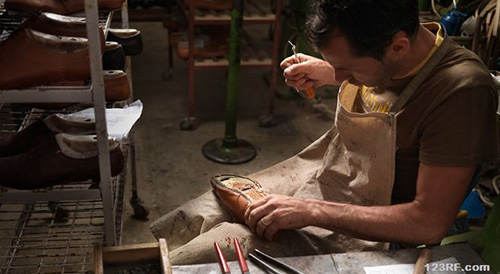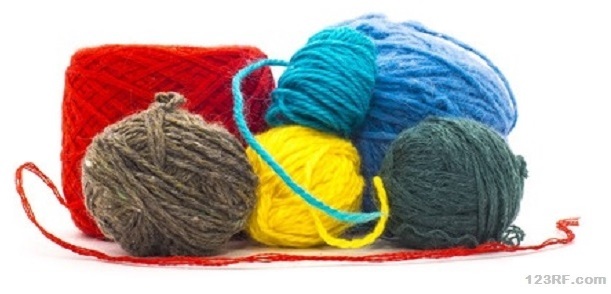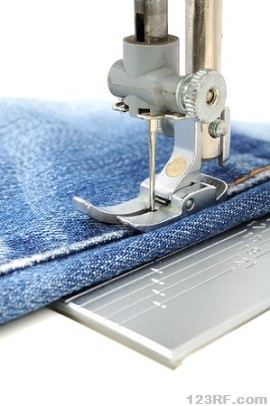If you walk into the local stores these days, it may be hard to believe that all those racks of clothes could ever be sold, let alone become unavailable.

On the other hand, the fact that clothes stay one store shelves for months on end is also a good indicator that people can’t afford to buy even the cheaper brands.
In a post crisis world, not only will it be impossible to buy clothes, you may also find it just as hard to buy material, patterns, and tools for making your own clothes and shoes. As someone that learned how to knit, crochet, weave, and hand sew by age 9, I can safely say there is far more to good quality, long lasting clothes than what you see in the stores.
When it comes to surviving a crisis, certain skills will make it possible to make the perfect clothes for any and every situation.
Old Skills Revival: DIY Clothes And Shoes
Fabrics for Making Clothes
There are many fabrics on the market these days made from petroleum and other non-organic materials. While these fabrics may be thinner and lighter, they also require a good bit of processing in factories before they can be used for clothing.
By contrast, our ancestors readily turned cotton, wool, hemp, and other plant based goods into textiles by using spinning wheels and looms. By the same token, stretching and tanning animal hides (including brain tanning) also offers a source of fabric from just about any animal you take for food.
Other Materials for Making Clothes
Chances are, you already realize that the textiles used for your garments are nothing more than a series of inter woven threads. Unfortunately, it is neither practical nor feasible to carry a fully functional loom around with you that can produce a good quality fabric.

On the other hand, spinning cotton, wool, and other materials into yarn using a drop spindle or spinning wheel requires far less equipment. Once you have yarn, you only need a crochet hook or pair of knitting needles to make sweaters, hats, gloves, socks, and other clothing.
Garment Fasteners
In the absence of zippers, hook and eyes, velcro, and other modern fasteners, you will most likely need to rely on buttons for garment fastening. Fortunately, buttons can be made from just about anything. You can use animal bone, wood, or just about anything else that you can poke 2 – 4 holes through.
Colors and Designs
When it comes to thinking about what the post-crisis world will look like, many imagine it will be a drab place with people wearing filthy clothes with holes in them and very little color. Long before we had commercial dyes, everything from blueberries to butternut hulls were used to make bright, lively colors. While the art of natural dye making takes practice and skill, you can easily start off with berries and other pigment sources.
Once you make dyes for textiles, you can either apply them directly to threads and yarns, or develop rudimentary silk screen or wax coating systems to create designs on fabrics. Needless to say, you can always experiment with tye-dyes and other fabric folding methods that limit dye spread from layer to layer.
Tools for Making Clothes
 Contrary to popular belief, you do not need a programmable sewing machine or other complex tools for making pants, shirts, sweaters, and even coats. Here are a few simple things you should have on hand.
Contrary to popular belief, you do not need a programmable sewing machine or other complex tools for making pants, shirts, sweaters, and even coats. Here are a few simple things you should have on hand.
Start off with making a light weight blouse, and then work your way up to heavier fabrics that require heavier threads and tighter stitches.
- Knitting needles
- Crochet hooks (size 5 for light weight, near-lace work, size G for sweater weight yarns)
- Tatting shuttle for making lace
- Various sized hand sewing needles
- Needle threader (optional)
- Thimble
- Seam ripper
- Small scissors for cutting thread
- Large scissors for cutting fabric
- Specialized scissors for cutting through leather and other animal hides
- Spools for holding spun thread and animal sinew
- Large brown paper bags suitable for making patterns
- Crochet and knit stitch size guides that can be used for developing garment designs
- Pins
- Flexible tape measure
- Leather punches
Materials for Making Shoes
The upper part of shoes can be made from wood, leather, or canvas. Unless you are planning to make lighter weight shoes, it will best to use the heaviest leather or canvas that you can make. It is also very important to use heavier threads or sinew for attaching upper and lower parts of the shoe.

In a post crisis world, you will find it very hard to obtain rubber, resin, and other materials used for soles. If you are fortunate enough to come across old or used tires, you can cut those up for shoe soles.
You can also use leather for lighter duty wear, or wood provided you design the shoe so that you can easily replace the soles.
Tools for Making Shoes
As with making clothes, you do not need complicated or power driven tools to make shoes. Here are the basics that will allow you to work with wood, leather, and fabric:
- Heavy scissors capable of cutting canvas and thick leather
- Leather hole punch
- Hammer
- Pliers
- Scraper
- Pattern
- Shoe form
When it comes to bugging out or preparing for a crisis, you will eventually realize that it does not make much sense to stockpile clothes. Even though modern fabrics are convenient, they can easily be replaced later on using materials that you grow or hunt.
From that perspective, keeping a few very simple sewing and shoe making tools on hand will be of immense benefit. If you start making your own clothes from crop growing to final product, you will also be able to pursue an enjoyable hobby that will also give you a tradeable skill later on.
This article has been written by Carmela Tyrell for Survivopedia.
Want to Know How Our Forefathers Made Their Own Clothes, Shoes And Many Other Things? Then you really need this amazing step-by-step guide. It is called The Lost Ways and it contains all the knowledge of our forefathers.
Here’s just a glimpse of what you’ll find in The Lost Ways:
From Ruff Simons, an old west history expert and former deputy, you’ll learn the techniques and methods used by the wise sheriffs from the frontiers to defend an entire village despite being outnumbered and outgunned by gangs of robbers and bandits, and how you can use their wisdom to defend your home against looters when you’ll be surrounded.
Native American ERIK BAINBRIDGE – who took part in the reconstruction of the native village of Kule Loklo in California, will show you how Native Americans build the subterranean roundhouse, an underground house that today will serve you as a storm shelter, a perfectly camouflaged hideout, or a bunker. It can easily shelter three to four families, so how will you feel if, when all hell breaks loose, you’ll be able to call all your loved ones and offer them guidance and shelter? Besides that, the subterranean roundhouse makes an awesome root cellar where you can keep all your food and water reserves year-round.
From Shannon Azares you’ll learn how sailors from the XVII century preserved water in their ships for months on end, even years and how you can use this method to preserve clean water for your family cost-free.
Mike Searson – who is a Firearm and Old West history expert – will show you what to do when there is no more ammo to be had, how people who wandered the West managed to hunt eight deer with six bullets, and why their supply of ammo never ran out. Remember the panic buying in the first half of 2013? That was nothing compared to what’s going to precede the collapse.
From Susan Morrow, an ex-science teacher and chemist, you’ll master “The Art of Poultice.” She says, “If you really explore the ingredients from which our forefathers made poultices, you’ll be totally surprised by the similarities with modern medicines.” Well…how would you feel in a crisis to be the only one from the group knowledgeable about this lost skill? When there are no more antibiotics, people will turn to you to save their ill children’s lives.
And believe it or not, this is not all…
Table Of Contents:
Making Your Own Beverages: Beer to Stronger Stuff
Ginger Beer: Making Soda the Old Fashioned Way
How North American Indians and Early Pioneers Made Pemmican
Spycraft: Military Correspondence During The 1700’s to 1900’s
Wild West Guns for SHTF and a Guide to Rolling Your Own Ammo
How Our Forefathers Built Their Sawmills, Grain Mills,and Stamping Mills
How Our Ancestors Made Herbal Poultice to Heal Their Wounds
What Our Ancestors Were Foraging For? or How to Wildcraft Your Table
How Our Ancestors Navigated Without Using a GPS System
How Our Forefathers Made Knives
How Our Forefathers Made Snow shoes for Survival
How North California Native Americans Built Their Semi-subterranean Roundhouses
Our Ancestors’Guide to Root Cellars
Good Old Fashioned Cooking on an Open Flame
Learning from Our Ancestors How to Preserve Water
Learning from Our Ancestors How to Take Care of Our Hygiene When There Isn’t Anything to Buy
How and Why I Prefer to Make Soap with Modern Ingredients
Temporarily Installing a Wood-Burning Stove during Emergencies
Making Traditional and Survival Bark Bread…….
Trapping in Winter for Beaver and Muskrat Just like Our Forefathers Did
How to Make a Smokehouse and Smoke Fish
Survival Lessons From The Donner Party
Get your paperback copy HERE
CHECK OUR survival and prepping solutions
If you found this article useful, please like our Facebook page and stay up to date with the latest articles.
WHAT TO READ NEXT:
HOW TO MAKE YOUR OWN BACON (STEP BY STEP GUIDE)
A RETURN TO THE OLD PATHS: HOW TO MAKE PEMMICAN LIKE THE NATIVE AMERICANS
20 LOST RECIPES FROM THE PIONEERS: WHAT THEY COOKED ON THEIR JOURNEY WESTWARD
SEVEN CLASSIC GREAT DEPRESSION ERA RECIPES GRANDMA USED TO MAKE
POTTED MEAT: A LOST SKILL OF LONG TERM MEAT STORAGE
BACK TO BASICS: HOW TO MAKE AND PRESERVE LARD
THE BEST WAY TO STOCKPILE VEGETABLES OFF-GRID
OLD FASHIONED PRESERVING-GRANDPA’S RECIPE FOR CURED SMOKED HAM
HOW TO MAKE GUNPOWDER THE OLD FASHIONED WAY
SURVIVAL HERBAL RECIPES FROM OUR ANCESTORS
HOW TO PRESERVE MEAT FOR SURVIVAL LIKE OUR GRANDFATHERS
OTHER USEFUL RESOURCES:
The 3 Pioneer Survival Lessons We Should Learn
The Most Effective Home Defense Strategies
Old School Hacks for Off-Grid Living
The Medical Emergency Crash Course
